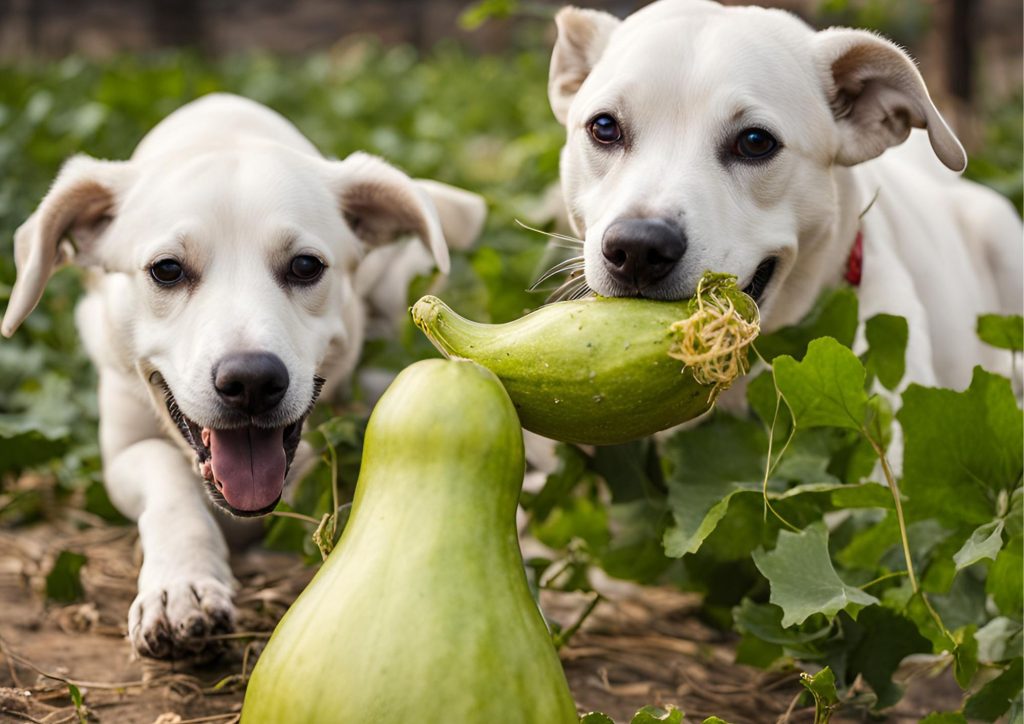As dog owners, we’re constantly looking for healthy, safe, and tasty foods to give our furry friends. With so many vegetables available, it’s essential to know which ones are beneficial and safe for your dog to consume. One vegetable that often sparks curiosity is bottle gourd, also known as lauki, calabash, or opo squash. While bottle gourd is popular in many households for its numerous health benefits, the question remains: Can dogs eat bottle gourd? In this article, we’ll explore the potential health benefits and safety tips for feeding bottle gourd to your dog, as well as any risks you should be aware of.
What is Bottle Gourd?
Bottle gourd (Lagenaria siceraria) is a vine-grown vegetable that has a smooth, light green exterior with a subtle flavor. Commonly used in various cuisines worldwide, particularly in South Asian, African, and Caribbean cooking, bottle gourd is renowned for its high water content, low calorie count, and impressive nutritional profile. It’s often used in soups, stews, and even juices.
Nutritional Profile of Bottle Gourd
Before delving into whether bottle gourd is safe for dogs, it’s essential to understand its nutritional content. Bottle gourd is low in calories and high in water, making it a hydrating and light food. Here’s a breakdown of some of the nutrients found in bottle gourd:
- Water content: 96%
- Low in fats: Contains negligible fats
- Carbohydrates: Provides a small amount of carbohydrates, making it a low-calorie food.
- Vitamins and minerals: High in vitamin C, vitamin A, folate, iron, magnesium, and potassium.
- Fiber: Contains a moderate amount of dietary fiber, which can support digestion.
Health Benefits of Bottle Gourd for Dogs
Now that we know bottle gourd is rich in nutrients, let’s explore how these components can benefit your dog’s health. Here are some potential benefits of feeding your dog bottle gourd in moderation:
1. Hydration Support
Dogs, like humans, need proper hydration to stay healthy. Since bottle gourd is composed of over 90% water, it can be a great way to keep your dog hydrated, especially during hot weather. Its high water content helps replenish fluids and prevent dehydration, especially for dogs that may not drink enough water on their own.
2. Promotes Digestive Health
Bottle gourd is a good source of fiber, which can aid in maintaining healthy digestion. Fiber helps regulate bowel movements and can prevent constipation or diarrhea in dogs. Additionally, the fiber content in bottle gourd may support gut health and promote the growth of beneficial bacteria in your dog’s digestive system.
3. Weight Management
If your dog is overweight, you may want to incorporate low-calorie foods into their diet. Bottle gourd is a great choice because it’s low in calories and high in water, making it filling without adding extra calories. The fiber also provides a sense of fullness, which may help in weight management.
4. Boosts Immune System
Rich in vitamin C and other antioxidants, bottle gourd can help support your dog’s immune system. Antioxidants help fight off free radicals, reducing oxidative stress and promoting overall health. Vitamin C is also important for collagen production and tissue repair, which benefits your dog’s skin, joints, and overall vitality.
5. Supports Healthy Skin and Coat
Vitamin A, which is present in bottle gourd, plays a crucial role in maintaining healthy skin and fur. This vitamin helps keep your dog’s skin soft, smooth, and free from irritation, while also supporting a shiny, healthy coat.
6. Promotes Heart Health
Bottle gourd contains magnesium and potassium, two important minerals for heart health. Potassium helps regulate blood pressure and supports proper heart function, while magnesium plays a role in muscle relaxation and energy production. These nutrients contribute to your dog’s cardiovascular well-being.
How to Safely Feed Bottle Gourd to Your Dog
While bottle gourd offers numerous health benefits for dogs, it’s crucial to follow some safety guidelines to ensure it’s fed in a way that’s both beneficial and safe. Here are some tips for incorporating bottle gourd into your dog’s diet:
1. Cooked, Not Raw
Raw bottle gourd can be tough for dogs to digest and may also contain toxic compounds, including cucurbitacins, which are naturally occurring in some cucurbit family vegetables. These compounds can cause nausea, vomiting, and gastrointestinal distress in dogs. Therefore, always cook the bottle gourd before offering it to your dog. Steaming or boiling it until it becomes soft is an excellent way to prepare it.
2. Peel the Skin
Bottle gourd skin can be tough and difficult for dogs to digest. It’s best to peel off the skin before feeding it to your dog. This will also eliminate any pesticides or chemicals that may be present on the skin.
3. Remove Seeds
If you’re giving your dog a portion of bottle gourd with seeds, be sure to remove them. Seeds can be choking hazards and may cause digestive issues or blockages, especially for smaller dogs.
4. Moderation is Key
Although bottle gourd can offer numerous health benefits, it should only be fed to your dog in moderation. Too much of any new food can lead to stomach upset or other digestive issues. Introduce bottle gourd slowly into your dog’s diet and monitor them for any signs of discomfort or allergies.
5. Avoid Seasonings and Spices
When preparing bottle gourd for your dog, avoid adding any seasonings or spices such as salt, garlic, or onions. These ingredients can be toxic to dogs. Stick to simple cooking methods, such as boiling or steaming, and avoid adding oils or fats that could be harmful.
Risks of Feeding Bottle Gourd to Dogs
While bottle gourd can be a healthy and nutritious addition to your dog’s diet, it’s important to be aware of some potential risks:
1. Gastrointestinal Issues
Introducing bottle gourd into your dog’s diet too quickly can cause gastrointestinal upset, including bloating, gas, diarrhea, or vomiting. Always start with small portions and observe your dog’s response before increasing the amount.
2. Allergic Reactions
Although rare, some dogs may have an allergic reaction to bottle gourd. Symptoms of an allergy may include itching, hives, or digestive upset. If you notice any signs of an allergic reaction, discontinue feeding bottle gourd and consult your veterinarian.
3. Potential for Toxicity in Raw Form
As mentioned earlier, raw bottle gourd can contain cucurbitacins, which may cause poisoning in dogs. Always cook bottle gourd before offering it to your dog.
Signs to Watch Out for After Feeding Bottle Gourd
After feeding your dog bottle gourd, keep an eye out for any unusual behavior or signs of discomfort. Some potential signs that your dog may be having a reaction to bottle gourd include:
- Vomiting or diarrhea
- Lethargy or lack of appetite
- Abdominal pain or bloating
- Skin rashes or itching
If you notice any of these symptoms, it’s best to consult with your veterinarian.
Conclusion
Bottle gourd can be a healthy and nutritious addition to your dog’s diet, offering hydration, digestive support, and essential vitamins and minerals. However, it’s essential to prepare it properly by cooking it, peeling the skin, and removing seeds. Always feed bottle gourd in moderation and monitor your dog for any adverse reactions. As with any new food, introducing bottle gourd gradually and in small amounts will help ensure that your dog enjoys its health benefits without any complications. If in doubt, consult your veterinarian before making any significant changes to your dog’s diet





